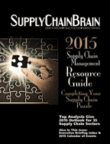
Visit Our Sponsors |
|
|
|
|
|
|
|
|
|
|
|
|
|
|
|
|
|
|
|
|
|
|
|
|
|
|
|
|
|
|
|
|
|
|
|
|
|
|

In order to achieve long-term collaboration, supply chain partners need to shift from simply saying collaboration and actually "being" collaborative. So what holds the majority back from achieving true collaboration? I'd argue a key factor is having the wrong mindset. Unfortunately, many approach collaboration with a "Me" mindset versus a "We" mindset that embodies trust, transparency and value creation. To truly collaborate, all parties must start with a spirit partnership.
Note that I said partnership. Our research at the University of Tennessee has found the best relationships take a broad view by looking at collaborative relationships holistically, as entities in and of themselves as partnerships. While there might not be a legal partnership – the spirit of the relationship is one of a true partnership. They are integrated.
Another way to think about it? Everyone is in the same boat, winning together and losing together.
So what is the secret sauce? Many have shown us the way to success, including McDonald’s, P&G and Microsoft. These highly collaborative relationships are profiled in Vested: How P&G, McDonald’s and Microsoft are Redefining Winning in Business Relationships. These organizations all follow five simple “Rules” that – when implemented – have the power to truly align and integrate the interests of business partners. We referred to these relationships as “Vested” because the success was defined by achieving a true win-win.
Win-win may sound like a buzz word but think about it. Why would a potential business partner such as a supplier want to truly collaborate and even invest in your success? The answer is simple. It’s when you’ve defined success and the economics of the relationship when a win for WE is also a win for ME.
What are the rules to creating a truly collaborative and integrated Vested relationship?
Rule 1. Outcome vs. Transaction-Based Business Model: Anchor your business model on outcomes versus transactions or activities. This way you will be focusing on the end game.
Rule 2. Focus on the WHAT, Not the HOW: If you dictate the HOW, you limit your ability to innovate. It’s like putting your supplier in a box while telling them you want them to think outside of the box.
Rule 3. Clearly Defined and Measurable Outcomes: It’s imperative to measure business outcomes, and not just the tasks.
Rule 4. Pricing Model with Incentives: Use a fully transparent pricing model with incentives based on overall total cost, not just price. The economics of should ensure you win together and you lose together.
Rule 5. Insight vs. Oversight Governance: Manage the business with your partner, rather than just managing your partner.
The Outlook
High-level collaborative partnerships are more than a trend or a nice phrase to include in an Annual Report. The best create physical agreements based on five rules that purposely align interests and “put the partners in the same boat.” If your business partner or supplier is not in the same boat rowing in the same direction, perhaps it’s time for you to reevaluate your relationship and seek a partner who gets the power of true collaboration and integration.
RELATED CONTENT
RELATED VIDEOS
Timely, incisive articles delivered directly to your inbox.

